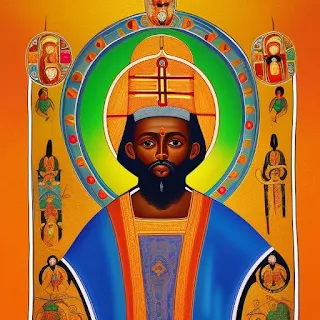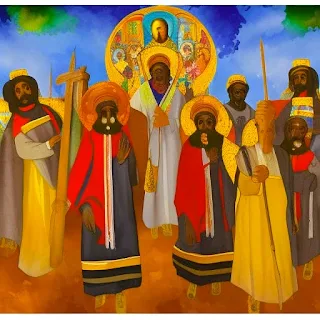Sacred Texts of Ethiopian Orthodox Christianity
The Kebra Nagast is a sacred Ethiopian text blending religion, history, symbolism, and parables.
The Kebra Nagast, often translated as the Glory of the Kings, is a sacred, prominent, and influential religious and historical text in Ethiopian Christianity. It is a sacred scripture of the Ethiopian Orthodox Tewahedo Church and holds a unique place in Ethiopian religious and cultural heritage. The Kebra Nagast is known for its extensive use of symbolism and allegory. It often employs allegorical interpretations of biblical events and characters, emphasizing spiritual and moral lessons.
Ethiopian Orthodox Christianity, often referred to as the Ethiopian Orthodox Tewahedo Church, is one of the oldest Christian traditions in the world, dating back to the 4th century. Ethiopian Orthodoxy has its own distinctive beliefs, practices, and liturgical traditions. It follows the Ge'ez Rite, which includes ancient liturgical texts and prayers written in Ge'ez, an ancient Semitic language.
The Kebra Nagast is often considered a sacred, significant religious, and historical text. It is revered for its historical and cultural significance but is not included in the standard liturgy of the Ethiopian Orthodox Church. Instead, it is considered a sacred historical text.
Compilation and Contents of the Kebra Nagast
The Kebra Nagast is a foundational religious text for Ethiopian Orthodox Christians. It reinforces the church's unique identity and spiritual connection to biblical narratives. The claim of a direct lineage from King Solomon and the Queen of Sheba gives Ethiopian Christianity a distinct and divine heritage.
The Kebra Nagast has significantly impacted the Rastafarian movement, particularly the belief in the divinity of Emperor Haile Selassie I of Ethiopia. Rastafarians view Selassie as a messianic figure based on the Kebra Nagast's assertion of the Solomonic lineage.
For Ethiopian Orthodox Christians, the Kebra Nagast offers spiritual guidance and interpretations of biblical events. It helps believers understand the significance of the Ark of the Covenant and its connection to their faith.
The Kebra Nagast allows for diverse interpretations, and different scholars and religious authorities may emphasize specific aspects of the text according to their theological or cultural perspectives. The Kebra Nagast offers interpretations of biblical events and teachings, guiding the spiritual lives of Ethiopian Christians. The story of the Ark of the Covenant, as narrated in the Kebra Nagast, holds special significance in Ethiopian Christian theology.
Significance of the Kebra Nagast
The Kebra Nagast is highly revered in Ethiopian Christianity and is often considered a historical and religious epic. It has played a crucial role in shaping the Ethiopian Orthodox Church's identity and its connection to the biblical narrative.
The Kebra Nagast has been pivotal in shaping Ethiopia's national identity. It asserts Ethiopia as a chosen land and the Solomonic dynasty as the rightful ruler. This concept of Ethiopia as the New Jerusalem has profoundly impacted Ethiopian history and politics, fostering a sense of unity and pride among Ethiopians. It gave the monarchs a divine right to rule and reinforced their claims to the throne. This played a crucial role in maintaining the stability and continuity of the Ethiopian monarchy for many centuries.
The Kebra Nagast asserts that Ethiopia is a chosen land, and the Ethiopian monarchs are descendants of King Solomon and the Queen of Sheba. This lineage is presented as a validation of the divine right to rule in Ethiopia. As a result, the Kebra Nagast has profoundly influenced Ethiopian history and politics, reinforcing the idea of Ethiopia as a New Jerusalem.
Kebra Nagast Literary Style
The Kebra Nagast, or Glory of the Kings, is renowned for its unique and distinctive literary style, combining religious prose, poetry, and historical narrative elements. This style reflects the blending of religious and historical storytelling found in Ethiopian literature.
The Kebra Nagast is written in Ge'ez, an ancient Semitic language that was historically used in Ethiopian religious texts. Ge'ez has a rich literary tradition and is still used in liturgical contexts within the Ethiopian Orthodox Church. Most people outside of Ethiopian Orthodox Christian circles are unfamiliar with Ge'ez, which is still used liturgically in Ethiopian churches.
The text features a combination of prose and poetry. It often transitions seamlessly between these two forms of expression. Prose is used for historical and narrative sections, while poetry is employed for lyrical and emotional passages.
The Kebra Nagast frequently emphasizes divine and royal themes, reinforcing the idea of Ethiopia as a chosen and sacred land. It underscores the divine nature of the Solomonic dynasty and its connection to King Solomon. The Kebra Nagast has a complex narrative structure that weaves together various stories, often with multiple layers of meaning. This complexity invites readers to explore the text's deeper theological and moral messages.
Beyond its religious significance, the Kebra Nagast has profoundly impacted Ethiopian culture and national identity. It has been a source of inspiration for art, literature, and music, and it continues to shape the way Ethiopians perceive their history and spirituality.






